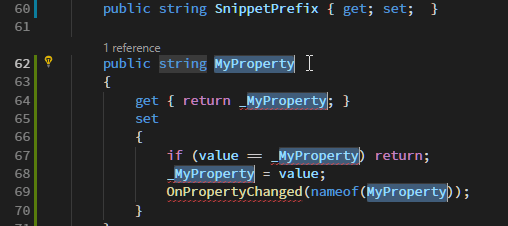

For more information refer to the VSCode documentation here. Workspace scoped settings will be stored inside your workspace and only apply when the current workspace is opened. Settings in the user scope will be applied globally for any instance of VSCode that is opened.

The preferences can be set for a given user or workspace, and depending on the environment, also for remote type and workspace folder. To see and change the configuration options in the VSCode window, go to “Code->Preference->Settings” and in the Search settings box type “ ansible” as shown in the below snapshot. There is also an option to enable the automation execution environment and users can choose the container engine, image name, pull policy and more. The Ansible extension supports multiple configuration options allowing, for instance, to change the executable path for Ansible, ansible-lint, python interpreter and so on.
#Visual studio code online snippet maker windows#

The status will be activated only after a file is opened in the editor and the language identified for the file is “ Ansible”.
#Visual studio code online snippet maker install#
In the VSCode Extensions tab, search and install the “Ansible VS Code Extension” as shown in the snapshot While running with an automation execution environment, ansible-core and optionally ansible-lint should be included. In addition, the language server relies on ansible-lint for providing diagnostic information if installed and enabled (default). The language server runs Ansible commands like ansible-config, ansible-playbook and so on to support these features and thus requires an Ansible package or ansible-core installed locally or within an automation execution environment. It serves the JSON-RPC request sent by the development tool (client).

Tomasz continues to be a core contributor to the Ansible extension and we would like to thank him and all the other community members for their contributions to help make the extension better for Ansible content creators with every new release. The Ansible Language Server is released as a node module on the npm repository, allowing it to be reused by other editors supporting language server protocol, while the VSCode extension client was released on the marketplace with many additional features. After the fork, the server and client-side code were decoupled into their own separate repositories to allow independent releases for both server and client. The Ansible VSCode extension was initially a fork of Tomasz Maciążek’s VSCode extension. In this blog, we will do a deep dive into the Ansible VSCode extension, giving an overview of how it works and the initial setup required to get it working after installation. The newly created Ansible Devtools initiative focuses on developing and enhancing tools like ansible-navigator, Ansible VScode extension, ansible-lint and so on to help ease the Ansible automation content creator experience. It is more important than ever that both new and experienced content creators have access to tools that help them write better content faster. Recent enhancements include Ansible Content C ollections, automation execution environments, and an increasing list of integrations using plugins and modules. Ansible as part of the Red Hat Ansible Automation Platform continues to grow and mature.


 0 kommentar(er)
0 kommentar(er)
